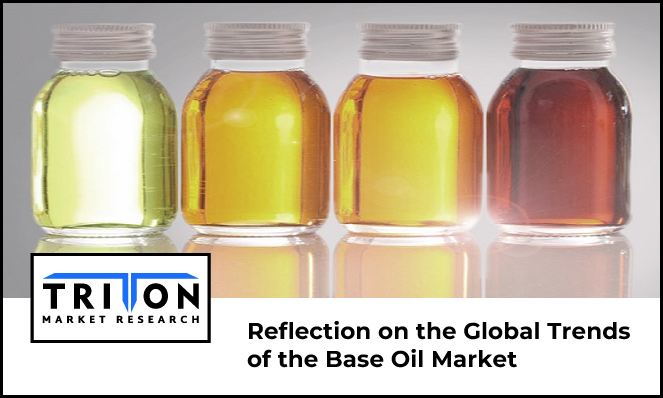



05, August 2022

Base oils, which are obtained by refining crude oil, serve as the foundation for manufacturing different lubricating products. They are necessary for ensuring the smooth functioning of a range of equipment, witnessing demand from the manufacturing sector. Increased industrialization worldwide is expected to increase the adoption of high-grade industrial lubricants across a range of industries.
As per our experts at Triton Market Research, the global base oil market is projected to perform at CAGRs of 3.42% (by revenue) and 3.95% (by volume) over the forecasted period of 2022-2028.
The growth of the automotive industry is a key contributor to the market’s growth. Lubricants help reduce heat generation and friction in a vehicle’s engine and steering components. They also facilitate the cooling of several components in specific circumstances.
Base oils are classified into different groups, namely Group I, Group II, Group III, Group IV, and Group V. They find multiple applications across a range of end-users to formulate lubricants like automotive oil, hydraulic oil, industrial oil, greases, metalworking fluids, and others, owing to their high performance and distinct characteristics.
Among all, automotive oil leads the application segment, with $13832.95 million and 15286.77 kilotons in 2021.
High-performing engines demand the use of high-grade lubricants. The use of automotive oils facilitate passenger cars, diesel trucks, and light-duty trucks to withstand rigorous and extreme conditions. Increased vehicle production and sales worldwide, coupled with stringent government standards concerning vehicular emission and fuel efficiency, have enhanced the adoption of these oils. Group I base oils are largely used in this application.
Environmental degradation due to greenhouse gas emissions is a serious issue. To counter this, governments across the world are implementing regulations that promote fuel efficiency for vehicles. According to the regulations set under the European Union Automotive Fuel Policy, the average CO2 emission levels for new passenger vehicles must not exceed 130 grams per kilometer. Such stringent environmental legislation has led car manufacturers to adhere to strict performance standards. This is expected to raise the adoption of high-performing engine oils, which ensure fuel efficiency by reducing friction, thus requiring less fuel consumption.
The Asia-Pacific region accounted for the largest share in the global market at $12258.46 million and 13575.10 kilotons in 2021. It is also expected to witness the fastest growth with CAGRs of 3.85% (revenue) and 4.38% (volume) during 2022-2028.
Factors such as surging investments in the automobile industry and enhanced production & sales of automobiles have primarily increased the demand for base oils in this region. For instance, new automobile sales in India grew from 2,435,100 units in 2020 to 3,082,400 units in 2021, with a rise of 26.7%. Further, the presence of leading market players and the expansion of production capabilities by China, South Korea, India, and others, have also driven the growth of the studied market.
The market witnesses a high level of competition due to the presence of established names like Shell Plc, Chevron Corporation, S-Oil Corporation, Neste Oyj, GS Caltex Corporation, and others, who account for a major market share. These players are increasingly launching innovative products, striking M&A deals, and increasing investments in R&D activities, as a part of their growth strategy to consolidate their brand and expand their consumer base as well as geographical footprint.
The need to shift towards a sustainable and low-carbon future has increased the demand for using renewable base oils across multiple applications. Several leading market players are innovating using advanced chemical conversion processes. For instance, Chevron Products Company and Novvi LLC announced producing a 100% renewable base oil, from the latter’s facility in Houston, Texas, in August 2020. Environment-friendly oils like these are designed specifically to facilitate lower carbon footprints, meet next-generation OEM specifications, and enable cost-effective formulations, which is expected to create lucrative growth opportunities for the global base oil market.
The global base oil market was valued at $29.70 billion in 2021 in terms of revenue, and is expected to reach $37.51 billion by 2028.
Q 2) What are the volume estimations for the market?The global base oil market was valued at 32697.08 kilotons in 2021 in terms of volume, and is likely to gain 42798.74 kilotons by 2028.
Image Source: bit.ly/3F0wh3L

Prevalent cases of terrorist attacks in today’s world is increasing the need for severe standards of security for public safety, and the global market for biometric technology scrupulously accommoda..
Prevalent cases of terrorist attacks in today’s world is increasing the need for..